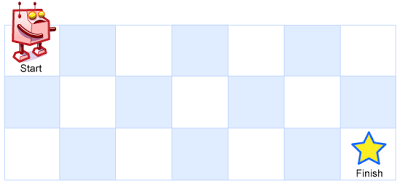25. Unique Paths
Problem Statement
There is a robot on an m x n grid. The robot is initially located at the top-left corner (i.e., grid[0][0]). The robot tries to move to the bottom-right corner (i.e., grid[m - 1][n - 1]). The robot can only move either down or right at any point in time.
Given the two integers m and n, return the number of possible unique paths that the robot can take to reach the bottom-right corner.
The test cases are generated so that the answer will be less than or equal to 2 * 10^9.
Example 1:

Input: m = 3, n = 7 Output: 28
Example 2:
Input: m = 3, n = 2 Output: 3 Explanation: From the top-left corner, there are a total of 3 ways to reach the bottom-right corner: 1. Right -> Down -> Down 2. Down -> Down -> Right 3. Down -> Right -> Down
Solution
import math
class Solution:
def uniquePaths(self, m: int, n: int) -> int:
# This is a combinatorial problem.
# To reach the bottom-right corner, the robot must make a total of
# (m - 1) down moves and (n - 1) right moves.
# The total number of moves is (m - 1) + (n - 1) = m + n - 2.
# The problem is to choose which of these total moves are "down" moves
# (the rest will be "right" moves).
# This is equivalent to "(m + n - 2) choose (m - 1)".
total_moves = m + n - 2
down_moves = m - 1
# Using the formula for combinations: C(n, k) = n! / (k! * (n-k)!)
return math.comb(total_moves, down_moves)
Explanation
This problem can be solved using dynamic programming, but a more efficient solution comes from combinatorics.
To get from the top-left corner (0, 0) to the bottom-right corner (m-1, n-1), the robot must make a total of (m-1) moves down and (n-1) moves right.
The total number of moves is (m-1) + (n-1) = m + n - 2.
The problem then becomes: out of these m + n - 2 total moves, how many ways can we choose m-1 of them to be "down" moves? (The remaining n-1 moves will automatically be "right" moves).
This is a classic combination problem, often denoted as "N choose K" or C(N, K).
Here, N = m + n - 2 and K = m - 1 (or n - 1, the result is the same).
The formula for combinations is C(N, K) = N! / (K! * (N-K)!).
Python's math.comb(n, k) function calculates this directly, providing a very concise and efficient solution.
Dynamic Programming Approach (for comparison):
You could also solve this with a 2D DP grid where dp[i][j] is the number of paths to cell (i, j). The recurrence would be dp[i][j] = dp[i-1][j] + dp[i][j-1], as you can only arrive from the cell above or the cell to the left. This would have O(m*n) time and space complexity.